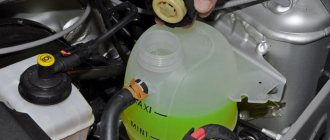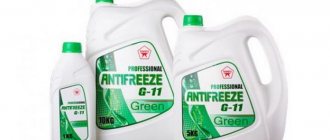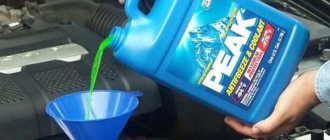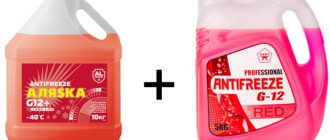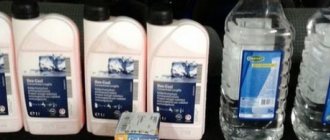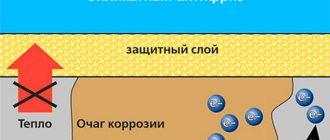Toyota is a Japanese concern, one of the leaders in global automobile production. Cars of this brand are distinguished by a variety of models, affordable prices, and high quality. To make them last longer, the concern recommends using only original fluids, including antifreeze. They are produced to order by the company at the best oil refineries in Europe and Japan.
Product Description
Toyota pink antifreeze is produced on the basis of polypropylene glycol with the addition of modern corrosion inhibitors. It is based on carboxylate (organic) technology. This means that the composition does not contain silicates, as well as nitrates and other components that lead to the formation of deposits. And the corrosion inhibitors involved are concentrated where they are needed most. This provides excellent technical characteristics - optimal heat transfer and heat removal from the operating internal combustion engine, protection against rust and deposits, high-quality lubrication and wear protection.
Antifreeze is available in two forms: Toyota Super Long Life Coolant Concentrated (concentrate) and Toyota Super Long Life Coolant Pre-Mixed (ready-to-use). The first requires dilution with water. And the second is suitable down to -40 degrees Celsius.
About Toyota antifreeze for cleanliness
We have already discussed with you some codes for Antifreeze... But I would like to point out that winter is coming and many have not yet changed the antifreeze... and are probably looking for the same codes or recommendations for replacement...
Original Toyota antifreezes come in two types: Long Life Coolant (LLC) - red Super Long Life Coolant (S LLC) - pink
Mixing these types of antifreezes in the system is highly not recommended. May lead to flushing of the entire system. 08889-80070 Antifreeze Toyota SUPER LLC, 2l. 08889-80071 Antifreeze Toyota SUPER LLC, 4 l. 08889-80072 Antifreeze Toyota SUPER LLC, 5 l.
08889-80014 Antifreeze Toyota LLC, 5 l. 08889-80015 Antifreeze Toyota LLC, 1l. 08889-80017 Antifreeze Toyota LLC, 60 l. 08889-80032 Antifreeze Toyota LLC, 4l.
Is it true that the original red antifreeze is better than others that the market offers us? It’s clear that “for Toyota” they produce a lot of all sorts of rubbish with supposedly original shields)))... Let’s look at everything in order and decide what to do and what we should do =) so that neither the radiator nor the engine kills... But there are no original replacements that fall under Toyota's recommendations, where there is no mandatory color match! After all, there is a document: Basic national standards for coolants JIS K2234 (Japan) And a recommendation from Toyota, which says that antifreeze should be silicate-free based on an organic “corrosion inhibitor”. Satisfy these 2 conditions:
SCT Mannol Longlife Antifreeze AG12+ SCT Mannol Antifreeze AF12+ -40°C Texaco Havoline XLC+B2 (OF02) Texaco Havoline XLC+B50/50 MAINTAIN FRICOFIN G12 Plus Panoil Kuttenkeuler ANF 40 (color: blue) Panoil Kuttenkeuler ANF 40 (color: green) Panoil Kuttenkeuler ANF 40 (color: yellow) Panoil Kuttenkeuler S 40 (color: red) AKIRA LLC (green) AKIRA LLC (red) KYK SUPER GRADE COOLANT (blue or red) XADO Antifreeze BS Hi-Gear Antifreeze “GOLD” Cool Stream Premium 40 (orange)
Currently, antifreezes, based on the type of anti-corrosion additives, are divided into silicate and carboxylate antifreeze. Silicate antifreeze, while protecting the OS from corrosion, during operation covers its entire internal surface with a thin layer of scale, which impairs heat transfer in the OS and reduces its efficiency. Manufacturers usually color silicate antifreeze green or blue.
Carboxylate antifreeze contains organic acid-based corrosion inhibitors. They do not form a thick protective layer over the entire surface of the system, but are adsorbed only in places where corrosion occurs, forming protective layers no more than 0.1 microns thick. In addition, carboxylate antifreeze has a longer service life (5 years versus 3 for silicate) and better cleaning properties, which makes it possible to avoid flushing the OS when changing antifreeze. Manufacturers usually color carboxylate antifreeze red.
The manufacturer Toyota itself does not recommend the use of “purely red antifreeze”; its recommendation only concerns the use of the original fluid, or compliance of the composition with certain chemical standards. This does not prevent other manufacturers from producing antifreeze with similar performance characteristics without being tied to color. And Toyota's recommendation will never concern color, because some Asian manufacturers divide the freezing temperatures of antifreezes by color. (red maximum -30, green -25, yellow -20 Also, it is not recommended to mix antifreezes, even if the colors match (and change completely!! especially if you don’t know what kind of liquid is poured into the radiator!!!), a common opinion about compatibility antifreeze by color is a mistake; color matching does not guarantee the use of the same additives, and the result of the interaction of different additives may be a deterioration in anti-corrosion and lubricating properties.
Any antifreeze is a mixture of ethylene glycol (polypropylene glycol), water, dye and additive package. By the way, TOSOL is also antifreeze. Initially, this was a nomenclature designation for antifreeze specially developed for VAZ cars during the construction of the plant in Togliatti. The Italians were not satisfied with the quality of the Antifreeze 156 that existed at that time in the USSR; they demanded the creation of a new antifreeze. TOSOL is an abbreviation: Technology of Organic Synthesis of OL (alcohol according to chemical nomenclature). Now this name has become simply a household name. Essentially, Antifreeze is a type of antifreeze, but it’s not suitable for us!!!
And so, if we consider antifreeze from all manufacturers, then each manufacturer uses its own package of additives, including even in the line of one manufacturer, antifreeze may differ in the number and composition of additives used. Additives can be anti-corrosion, anti-foam, reducing the impact on rubber, etc. If you look back into the past, in the 70s European manufacturers decided to create a classification of Coolant. And three classes were accepted.
G11 - ethylene glycol is used, usually the cheapest coolant, with a small additive package. This class was assigned the color green. By the way, colors were introduced so that liquids of different classes could be distinguished. Before this, the liquids were colorless.
G12 - ethylene glycol and carboxylate compounds are used. Due to the fact that the anti-corrosion film is created only in the hot spots, and does not cover all internal surfaces, heat removal when using this antifreeze is more effective than that of G11. Best suited for high-speed and temperature-loaded engines. Due to a more advanced package, e-liquids of this class are more expensive. This class was assigned the color red.
G13 - polypropylene glycol is used. This is a more environmentally friendly product (non-toxic, decomposes faster). Europe is pursuing environmental friendliness, which is why they create such products. By the way, these are the most expensive coolants. This class is assigned a yellow or orange color. In Russia, not a single manufacturer makes G13 class liquids. We’re not old enough to chase the environment for that kind of money =).
But most Russian and Asian manufacturers do not adhere to this classification. Take the same TCL: it has both green and red fluids of the G11 class, but they differ in the additive package (red is more advanced). Therefore, the manufacturer introduced color divisions to differentiate the product for the end customer. Take for example the original Honda antifreeze - it is made in green color (well, that’s what they wanted), but its properties correspond to the G12 class. This is where the confusion comes from. In general, don’t get hung up on the color, take at least blue antifreeze, as long as it is of high quality and matches the temperature regime of your engine (for a Honda, the boiling point at a pressure of 1.1 should be no lower than 108 degrees).
As for corrosion: it all depends on the additive package, as well as on its balance. At first, almost all lower-quality liquids provide the same protection against corrosion, but over time, in cheap products, the additives are used up, decompose, and only a mixture of glycol and water circulates in the cooling system; naturally, there is no talk of any protection. Therefore, if you fill in TCL and change it every 6-12 months, nothing bad will happen even for Honda engines, but you can buy expensive antifreeze and change it every 3-4 years. It's up to the buyer.
About mixing theoretically: it is allowed to mix liquids of classes G11 and G12 from the same manufacturer. This may cause a color change.
In emergency cases (on a long trip in the absence of other options), you can mix fluids from different manufacturers, but replace them with fresh ones with a complete flush as quickly as possible. Due to the different composition of additives, they may begin to interact and precipitate, worsening the properties of the coolant.
About European manufacturers: now 90% of the European additive package market is occupied by BASF. For decades now they have been producing the so-called super concentrate for classes G11 and G12 (just a package of additives). This product is branded as Glysantin.
Manufacturers such as Castrol, Mobil, Agip, Addinoil, etc. they buy Basovsky superconcentrate, add water and ethylene glycol, pack it in cans and sell it. :))). The same AWM is also produced from this masterbatch. So, the Castrolov antiphysics, the mobile, and the awm are internally the same thing.
Application area
If it is difficult to decide what antifreeze to pour into a Toyota, you should opt for this product. Toyota Super Long Life antifreeze is recommended for all modern trucks and cars of this brand. It also meets the requirements of not only Japanese, but also other Asian, American, and European manufacturers.
Used for conveyor filling.
Other antifreeze from the Toyota line:
- Toyota Long Life Coolant RED (LLC) (concentrate).
Toyota Super Long Life Coolant Concentrated Pink 1l.
Reviews
David, 52 years old I use new Toyota antifreeze, Super Long Life. It has a much more modern composition and higher quality than the simple one. Well, you can change it less often. Just don't mix it with anything.
Vadim, 46 years old I advise everyone to use a concentrate rather than a ready-made Super Long Life cooler. Why? Because the price, to be honest, is a bit steep, and the concentrate is much cheaper. In addition, it can be bred in accordance with your weather; if there are no severe frosts, it will be even cheaper.
Arthur, 37 years old Long Life is an excellent antifreeze for Toyota. Never thickens, foams or boils. I use it like I bought a car, and I see no point in experimenting and looking for something else.
Ivan, 35 years old I have been using the original Long Life in my Toyota for a long time. I can say that in the five years that I have had this car, I have never had any problems caused by antifreeze. The cooling system is in perfect order, as is the engine.
Release form and articles
Toyota Super Long Life Coolant Pre-Mixed Pink (SLLC)
- 08889-80150 Toyota Super Long Life Coolant Pre-Mixed Pink (SLLC) (ready) (plastic bottle) 1 l;
- 08889-80070 Toyota Super Long Life Coolant Pre-Mixed Pink (SLLC) (ready) (plastic bottle) 2 l;
- 08889-80071 Toyota Super Long Life Coolant Pre-Mixed Pink (SLLC) (ready) (canister) 4 l;
- 08889-80072 Toyota Super Long Life Coolant Pre-Mixed Pink (SLLC) (ready) (canister) 5 l.
Toyota Super Long Life Coolant Concentrated Pink (SLLC)
- 08889-80140 Toyota Super Long Life Coolant Concentrated Pink (SLLC) (concentrate) (plastic bottle) 1 l.
Instructions for use
Ready-made antifreeze is intended for direct pouring into the vehicle cooling system. The concentrate should be pre-diluted with distilled water. In a climate where frosts can reach -40 degrees Celsius, the optimal ratio is 1:1. In general, the content of the concentrating liquid can vary from 33 to 70%.
This fluid should be changed for the first time in a new Toyota upon reaching 160 thousand km. In the future - every 80 thousand km or every 5 years. This period should vary based on the actual operating conditions and technical condition of the machine. Before first use or after using another type of antifreeze, it is recommended to flush the cooling system.
Timing for replacing coolant in Toyota Land Cruiser Prado 150
The coolant replacement period is not clear cut. The timing depends on the operating conditions of the machine, as well as on the properties of the coolant itself. Fluids of class G11 are recommended to be changed every 3 years, and G12 after 5 years. It is also recommended to change the coolant after covering 40 thousand km. If the engine operates under increased loads, the coolant also wears out faster.
Here are a few factors that influence antifreeze replacement:
- vehicle condition;
- mileage;
- coolant composition.
Antifreeze replacement in Toyota Land Cruiser Prado 150 is carried out under the following symptoms:
- cloudiness and loss of color;
- the appearance of foam and scale;
- separation of the liquid and the formation of white flakes in it;
A replacement will require about 9 liters of coolant.
How to spot a fake
The most reliable way to buy original Toyota SLLC antifreeze is from an official distributor. However, this is not always possible. If you have to buy from a dubious store, you should pay attention to whether it is a fake. The following signs that distinguish the original will help:
- mandatory indication of the date of release and bottling, where they are produced, main characteristics, tolerances;
- high quality of the canister and absence of defects and signs of opening;
- even sticking of labels, without glue drips or folds;
- clear text printing, without blurred or erased areas, without grammatical errors.
The liquid itself is transparent, without sediment, pink in color.
Packaging of Toyota Super Long Life Coolant Pre-Mixed Pink 5 and 1 l.
Advantages and disadvantages
Toyota pink antifreeze has the following advantages:
- maximum protection against corrosion;
- compliance with the approvals of the world's leading automakers;
- versatility of use;
- absence of components that would cause deposits;
- excellent heat transfer properties;
- maintaining normal thermal operating conditions of the internal combustion engine;
- Effective prevention of cavitation and foaming.
Consumer reviews show that the liquid is excellent. The only thing that can be considered a drawback is the slightly higher cost than non-branded analogues.

